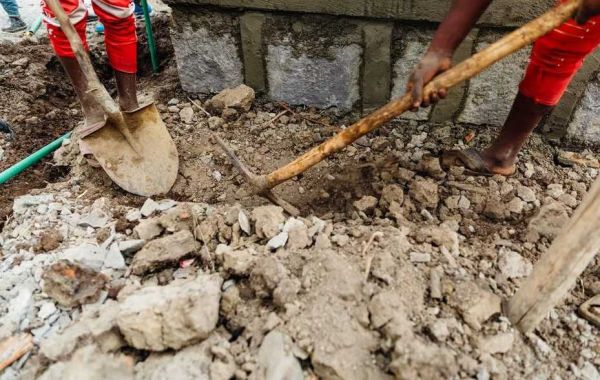1. What precautions should be taken when entering coarse and fine aggregates?
Coarse aggregate should mainly control its particle size, grading, particle shape, stone powder content, and clay block content. Each vehicle shall undergo a macroscopic inspection and shall not be unloaded if it fails to meet the requirements; In addition, various indicators should be inspected in batches according to regulatory requirements.
Fine aggregate should control the fineness modulus, mud content, and clay block content. Perform a macroscopic inspection on each vehicle, and do not unload if it is found to be unqualified; Batch inspection should also be conducted in accordance with regulatory requirements.
2. Why should the particle size of coarse aggregate be controlled between 5-25mm?
The particle size of coarse aggregate is constrained by the diameter of the concrete pumping pipeline and the pumping height. Generally, the maximum particle size that can be pumped decreases with increasing pumping height. When the pumping height is less than 50m, the ratio of the maximum particle size of coarse aggregate to the conveyed diameter is ≤ 1:3; When the pumping height is 100m, the ratio drops to 1:5, otherwise it is prone to pipe blockage.
3. Why should the needle like content of coarse aggregate be controlled when pumping concrete?
When its content is high, the flexural strength of needle shaped coarse aggregates is relatively low, and the bonding strength between coarse aggregates decreases, resulting in a decrease in concrete strength. For ready mixed concrete, a high content of needle shaped aggregates can lead to poor particle shape of coarse aggregates, resulting in decreased fluidity of the concrete. At the same time, needle shaped aggregates are prone to clogging at pipeline locations, causing pump blockages and even pipe bursts. Therefore, pumping concrete requires a needle content of ≤10%, and the requirement for high-strength concrete is even higher.
4. What kind of sand is needed for ready mixed concrete?
Ready mixed concrete requires medium sand. In addition to complying with the specifications for sand grading, mud content, and mud block content, it is important to ensure that no less than 15% of the sand passes through a 0.315mm sieve. This has a significant impact on the pumpability of concrete, as a low value can easily clog the pump and result in poor water retention and easy bleeding of the concrete.
5. What impact will fine sand have?
The sand is too fine, the water demand for concrete increases, and the pumpability and plasticity of concrete prepared with fine sand are extremely poor. The strength of concrete will decrease and it is prone to cracking.
6. What if there is only fine sand?
If there is a problem with the sand source, fine sand and some machine-made sand can be used to prepare pumpable concrete. For example, fine sand with a fineness modulus less than 2.0 can be mixed with machine-made sand with a fineness modulus of 3.0-3.2 in a ratio of about 6:4. The flowability and pumpability can be observed, and the specific ratio can be determined through experiments.
7. What are the consequences of high sand content?
The sand has a high mud content, the concrete requires a large amount of water, poor plasticity, increased shrinkage, decreased concrete strength, and the structure is prone to cracking. Therefore, it is necessary to control the sand mud content to be ≤ 3% (C30-C50), and the mud content requirement for high-strength concrete is higher.
8. What impact will mud lumps in sand and gravel have on concrete?
Mud blocks in sand and gravel not only have the same impact as mud, but also seriously affect the strength of concrete. For example, mud blocks can weaken the cross-section of concrete. When pouring the ground, the mud blocks will float up, and after drying and shrinking, defects such as pits will form on the surface.
9. Why should smaller sized stones be used when preparing high-strength concrete?
As the particle size of coarse aggregate increases, its bond with cement slurry weakens, increasing the discontinuity of the internal structure of concrete materials and leading to a decrease in concrete strength. Coarse aggregate plays a constraining role in cement shrinkage in concrete.
Due to the different elastic module of coarse aggregate and cement slurry, tensile stress is generated inside the concrete. This internal stress increases with the increase of coarse aggregate particle size and can lead to a decrease in concrete strength.
With the increase of coarse aggregate particle size, the orientation and arrangement of Ca(OH)2 crystals in the transition zone of coarse aggregate interface increase, which weakens the interface structure and reduces the strength of concrete. Experiments have shown that the width of interface cracks around coarse aggregates with a particle size of 15-25mm in concrete is about 0.1mm, and the crack length is 2/3 of the particle size circumference. The interface cracks are more connected to the cracks in the surrounding cement slurry.
However, in coarse aggregate concrete with a particle size of 5-10mm, the width of interface cracks is relatively uniform, only 0.03mm, and the crack length is only 1/6 of the particle size circumference.
Coarse aggregates with different particle sizes have varying amounts of water pockets formed in the lower part of the particle size after concrete hardening. For larger coarse aggregates, the water pockets in the lower part are larger and more numerous. After the water in the water pockets evaporates, the interface seams formed at the lower interface are inevitably wider than those of smaller particles, resulting in lower interface strength.
10. Why is the strength of pebble concrete 3-4MPa lower than that of crushed stone concrete with the same mix ratio?
The surface roughness of coarse aggregate is due to the interfacial strength between cement slurry and aggregate. According to the author’s years of experiments, concrete prepared with pebbles has a lower crushing index than crushed stone due to its high content of weathered stones. Additionally, the surface is smooth and the interfacial strength is low. Therefore, the strength of concrete prepared with pebbles is 3-4 MPa lower than that of crushed stone concrete with the same ratio.
More details on construction materials are available on ltconcretepump.com.
11. Why is it necessary to measure the moisture content will have an impact on the water consumption of concrete by 8-11kg. Especially sand, which is usually collected from rivers and has a large variation in moisture content, if the moisture content is not regularly detected and the mixing water consumption is adjusted in a timely manner, it will cause significant fluctuations in the slump, pumpability, and strength of each batch of concrete.
12. What is alkali aggregate reaction?
The alkali in the concrete reacts with the aggregate whose chemical composition is active silicon dioxide. After the alkali silica gel is formed, it absorbs water and expands. The expansion stress makes the concrete crack. This process is called alkali aggregate reaction.
13. How to prevent alkali aggregate reaction?
If the local coarse aggregate contains active silica, the alkali content of concrete admixtures should be strictly limited.








